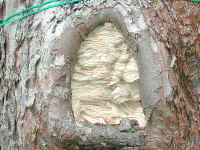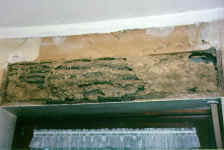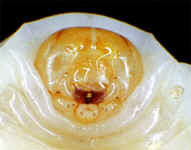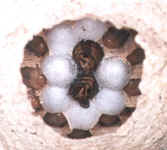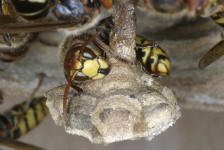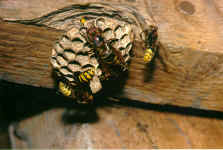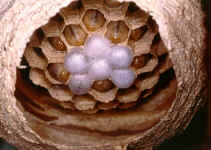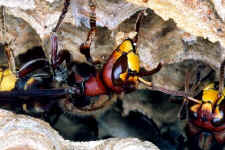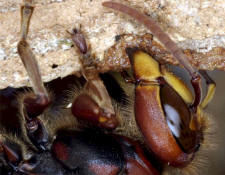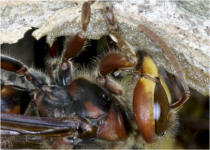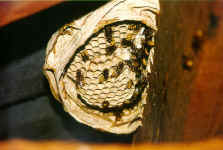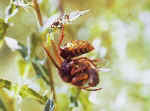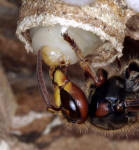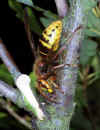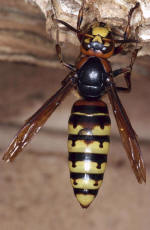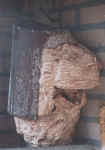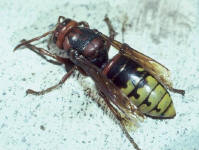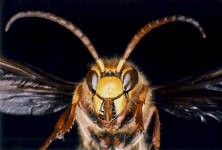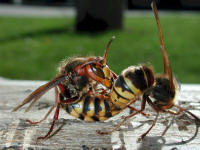Life cycles of a hornet colony Establishment of the colony by the young queen click on thumbnails to enlarge the images The arrival of warm April days marks the emergence of the new queens, born and mated the previous autumn. They survive the harsh winter in rotten wood or the soil, their metabolism slowed down to a minimum. They also produce Glycerol, which acts as an antifreeze! After emerging their first task is to undertake investigation flights to find a suitable nesting-place and food in the form of tree sap and insects. When the queen has decided on a nesting-place, she first makes a small pedicel (stalk) from which the nest will be suspended. The first cell are built outwardly from it and are soon all occupied with eggs. After five to eight days small larva (quantity 1-2mm) develop, which during the coming twelve to fourteen days pass through five larval stages. The young hornet then bites its way out of the cell. The newly eclosed worker will then rest, in an apparently idle fashion, in the cell from which it has emerged. Building material, contrary to other "general forage loads" such as water, carbohydrate-rich juices, and proteins in the form of insect prey, is not shared with other female workers in the nest. The foragers continue to process it and then add the building material to the nest structure themselves. A freshly emerged female worker (who does not go on foraging trips yet) can not, therefore, do construction work at the nest for this period. Workers will stay in the nest for two to three days before taking their first flight. Around this time a paper sleeve is started, which will eventually cover and protect the cells. Each worker cell can be reused up to four times. After five to ten female workers have emerged, the queen starts to fly from the nest less and less, with the workers taking over the role of foraging. Workers are noticeably smaller (18-25mm) than the queen (35mm), and only live for three to four weeks. Eventually the queen becomes nest bound and will never leave the nest again. With queen safely hidden in the nest, the most dangerous time for the colony has now passed. The queen now focuses solely on reproduction, the function she will perform until her demise at the end of the season.
More workers must be raised to allow the colony to grow. They work tirelessly collecting food, building materials and water. Hornets continue to forage, even at night during humid, windless weather! Hornets are attracted to bright lights like moths causing them to become disorientated. As a result, they often crash against window panes sometimes scaring the people inside. By turning out the light the however they are able to rapidly reorientate and will move on. Hornets are capable of flying with light intensity of 0,01 Lux, at which the human eye is completely useless. On warm summer days, the workers moisten the surface of the cells with water and so lower the temperature through evaporative cooling. After completing the first comb a new pedicel is built to allow construction of a new tier. Construction occurs basically downwards from the first comb, with additional lateral expansion of each comb and the paper.
Hornets and other social wasps use paper (wood pulp) to construct their nests. In other words: they use rotten wood as the main building material for the nest. They scrape it from worn and weathered wooden fences, buildings, telephone poles, and other sources. They mix this with saliva and chew it up into a ball with their mandibles (mouth parts). This makes the wood fiber extremely soft and moist. After a period of chewing, the hornet adds the paste to the nest structure and spreads it out with her mandibles and legs. After it thoroughly dries; a type of tough, durable paper is formed. The stripy pattern produced on the comb is characteristic of the hornet, each different coloured stripe representing the pulp from a different tree. The strongly structured nest - covering with its fine grain and the numerous shell-like formed out air bags - reminds of veneer wood from different wood.
Nutrition of the brood and final development of the nest The hornet is essentially a predator of a wide variety of insects. Larvae are nourished by the adults with this mixture of captured insects, paralyzed and masticated, which they regurgitate. If larvae are hungry, they are able to make a noise, listen here. In addition they eat the juice of ripe fruits: sap, juices of ripe fruits: apples, pears, plums and nectar. Hornets forage up to 1500 m from their nest.
Unlike wasps, hornets don't plague picnic areas in the summer in search of food. There is thus no danger of being stung in the throat by a hornet! In the absence of natural nest-cavities, hornet-queens sometimes settle in the spring in bird nest-boxes, although these rarely offer enough space for a mature hornet colony. By the early summer, with 25 to 30 workers and three to four combs such boxes are full. Thus the only possibility is to build outside the box or look elsewhere. In the latter case, workers fly out to search for suitable sites in the neighbouring area. If successful, some female workers fly with the queen to a new, larger cavity where a new secondary nest is established. This process is called "relocation". Workers fly between the new and the old nest tending for both. The brood in the old nest are raised to adulthood while the construction of the new nest is underway. Eventually all the hornets move to the new secondary nest and the old nest becomes disused. How exactly the hornets are able to direct each other to the new nest site remains a mystery, although chemical signals are probably used. In the time between mid August and mid September, the hornet colony achieves its developmental peak, amounting to 400 - 700 animals and a 60 cm high nest. The queen now lays eggs, which become males (also called drones, quantity 21-28mm) and young queens. Mating of the new queens and their hibernation The workers are now busy feeding the sexuals with protein and carbohydrates. This provides the young queens with the necessary reserves for the long hibernation phase.
On beautiful autumn days, the sexuals swarm out to mate. Old nests are never resettled the following year. Many young hornet-queens do not make it through the winter falling victim to fungal attack or predation by insectivores.
Next Page: Hornets are worthy of protection!
Hymenoptera>Vespoidea>Vespidae>Vespa crabro>Hornisse>Hornet>Frelon>Hoornaar>Vespa grande>Abejorro>Calabrone Webmaster: Hymenoptera>Vespoidea>Vespidae>Vespa crabro>Hornisse>Hornet>Frelon>Hoornaar>Vespa grande>Abejorro>Calabrone
|
